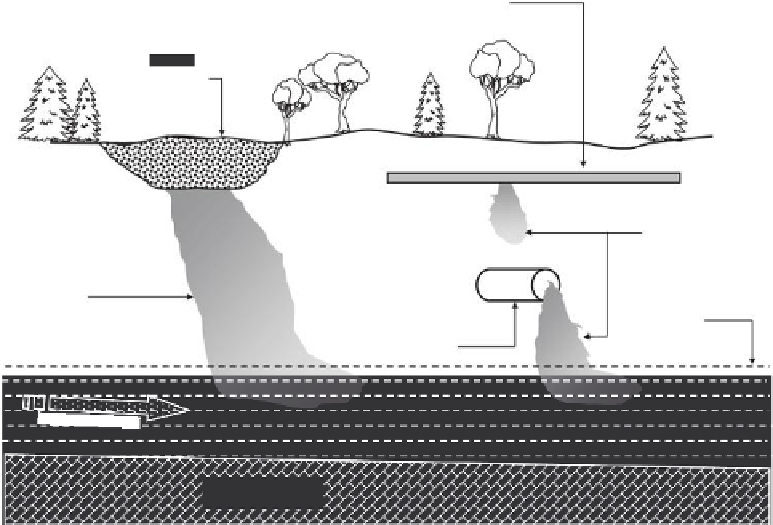Environmental Engineering Reference
In-Depth Information
Buried pipeline
Buried pipeline
Waste
landfill
Waste
landfill
(a)
(a)
Contaminant
plume
Contaminant
plume
(b)
(b)
Leachate
(contaminant plume)
Leachate
(contaminant plume)
Water
table
Water
table
Underground
storage tank
Underground
storage tank
Bedrock
FIGURE 9.8
Schematic showing (a) leachate plume with contaminants and (b) contaminant plumes from a leaking under-
ground storage tank and leaking buried pipeline.
leachates include biochemical oxygen demand (BOD
5
), chemical oxygen demand (COD), total
suspended solids (TSS), total dissolved solids (TDS), pH, total nitrogen (N) and total organic
carbon (TOC). Typical organics found in MSW leachates include phenols, volatile acids, organic
nitrogen, tannins, lignins, oil, and grease, and chlorinated hydrocarbons. One of the many
problems encountered when various kinds of organic and inorganic chemicals and elements
are combined in a mixture is the reactions that can occur between some of the constituents. For
example, reactions between halogenated organics and metals will generate heat in a leachate
stream. If this occurs in a relatively dry environment, ire will result. The same occurs when
saturated aliphatic hydrocarbons and phenols interact with oxidizing mineral acids.
The constituents of leachate streams in hazardous waste landills are intimately asso-
ciated with the composition of the hazardous waste contained in the landill. The con-
taminants of concern in the leachate streams are both inorganic and organic in nature.
Heavy metals constitute the primary inorganic contaminants whereas the organic con-
taminants can cover a whole range of organic chemicals, from volatile organic chemicals
(VOCs) to synthetic organic chemicals (SOCs). For both the MSW and hazardous waste
landills, the principal sets of problems, outside of the control and remediation-type prob-
lems, concern determination of the transport and fate of the contaminants. Knowledge
or prediction of where, when, and extent of leachate penetration into the subsurface sur-
roundings will provide one with (a) the requirements for a proper and effective subsurface
monitoring program using monitoring wells and other sensing devices and (b) the pos-
sible scenarios for various management options and remedial actions. The procedures and
requirements shown in Figure 9.7 in respect to surface discharge problems also apply to
subsurface discharges. A summary of the various transport processes involving sorption














Search WWH ::

Custom Search